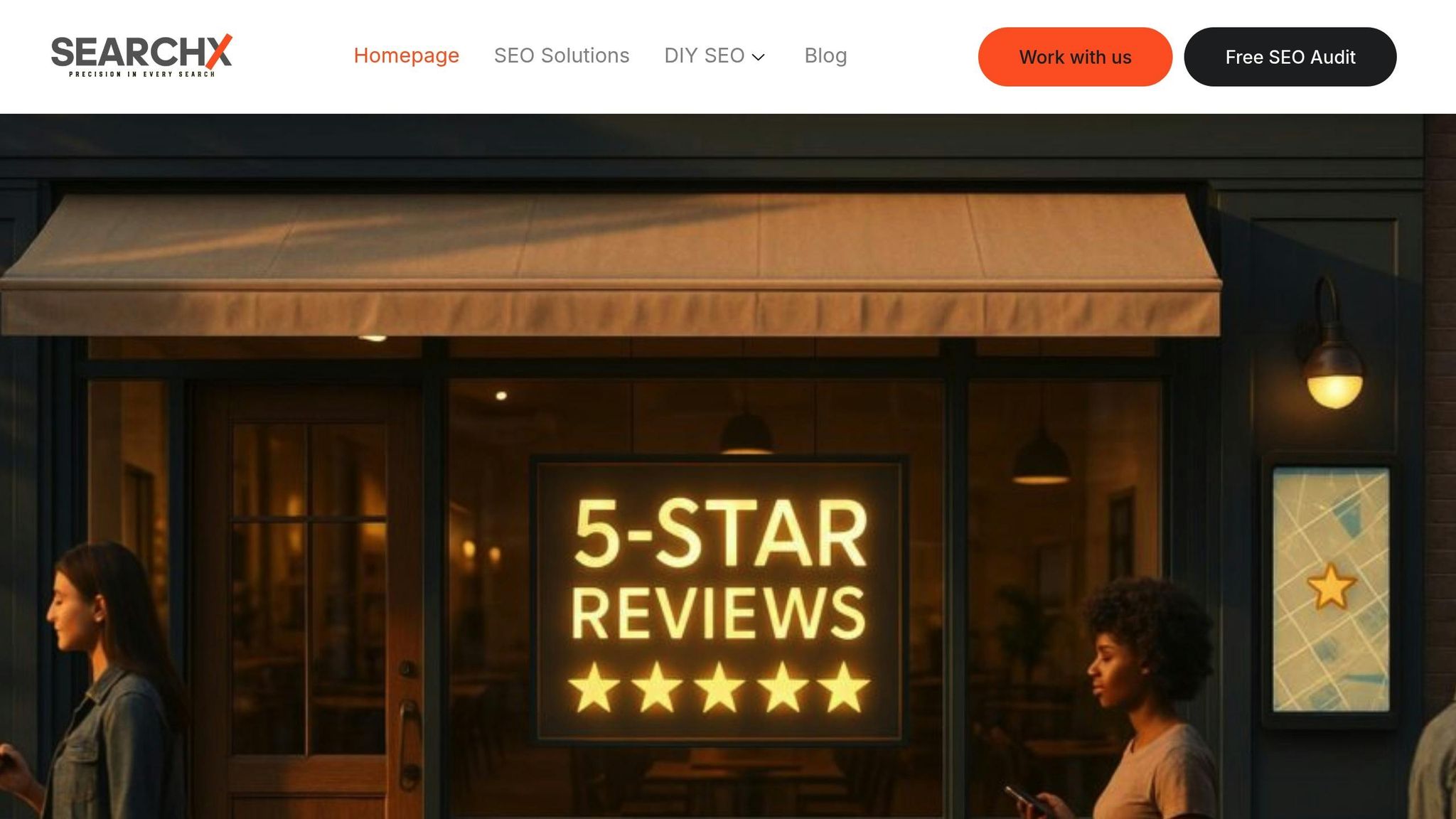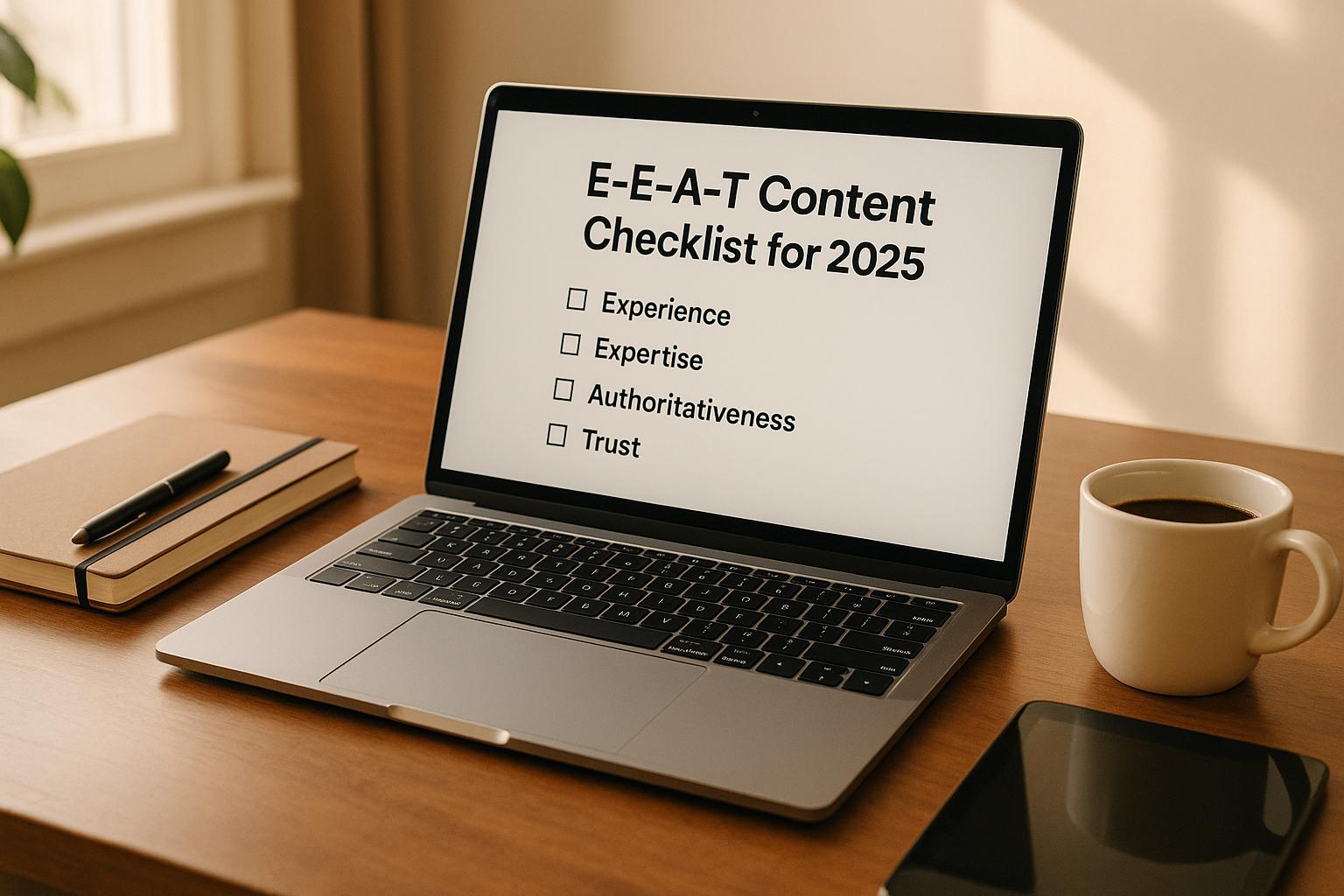Google’s E-E-A-T (Experience, Expertise, Authoritativeness, and Trustworthiness) framework is critical for ranking content in 2025. Here’s what you need to know:
- Experience: Firsthand knowledge is key. Content that reflects direct interaction with products, places, or topics ranks higher.
- Expertise: Demonstrate authority with qualified authors, accurate sources, and up-to-date information – especially for sensitive topics like health or finance.
- Authoritativeness: Build domain authority through internal linking, external endorsements, and comprehensive coverage of topics.
- Trustworthiness: Ensure transparency with clear author bios, contact details, and structured data. Use HTTPS and display privacy policies prominently.
Practical Tips:
- Use original examples, photos, and case studies to showcase firsthand experience.
- Combine AI tools with human editing for depth and accuracy.
- Highlight author credentials and regularly update content to stay relevant.
- Implement structured data to signal credibility to search engines.
Neglecting these factors can lead to lower rankings, reduced traffic, or even de-indexing. To succeed in SEO this year, focus on creating content that’s accurate, reliable, and genuinely helpful to your audience.
SEO in 2025: Mastering E-E-A-T & YMYL | Expertise & SEO Rankings | From Zero to Authority
Experience: Showing First-Hand Knowledge
Experience has become a game-changer in defining content quality. Google’s Search Quality Rater Guidelines emphasize this, asking, "Does content also demonstrate that it was produced with some degree of experience, such as actual use of a product, having visited a place, or communicating what a person experienced?". This isn’t just a buzzword – it’s a core requirement for ranking well as we move into 2025. Authentic, firsthand experience stands out to Google as a way to differentiate human-created content from AI-generated material. As Google notes, "An authentic experience with a subject is (currently) outside the scope of AI capabilities".
Adding Real-World Insights
Real-world insights elevate content from ordinary to exceptional. The most successful websites in 2025 share a common thread: they showcase genuine, hands-on knowledge of their topics.
Take Epic Gardening, for example. Kevin Espiritu turned his personal gardening experiments into one of the top gardening resources online, despite not having formal training in horticulture or landscaping. Similarly, Homesteading Family thrives by sharing practical advice rooted in their self-sufficient lifestyle on a 40-acre property. Their content on growing, preserving, and preparing food reflects authentic, lived experience.
High-performing content often includes proof of firsthand experience – whether through photos, videos, or data-driven case studies. Since Google’s product review update in 2021, reviewers are expected to provide evidence of actual usage and ownership. Backlinko’s SEO Strategy Guide is a standout example, consistently ranking at the top for "SEO strategy" by sharing internal experiments and campaigns that demonstrate real-world application. This approach works: 73% of successful content marketers incorporate case studies into their strategies, and those who do generate 70% more leads.
User-generated content also adds a layer of credibility. Customer reviews, testimonials, and social proof are powerful tools for building trust. In fact, 74% of buyers check reviews before making a purchase, and 69% are most influenced by genuine endorsements.
These insights underline the importance of blending authentic human experience with content creation, setting the stage for how AI-generated content can be improved with human expertise.
Improving AI-Generated Content with Human Input
While AI can be a powerful tool, it can’t replace the depth and nuance of human experience. Google increasingly values this human element. The "30% rule of AI" suggests that about one-third of tasks can be automated, but the remaining 70% still requires human expertise and judgment. Studies show that human-generated content outperforms AI in user engagement by about 47%.
As The Ad Firm puts it, "Google’s algorithms prioritize content quality, usefulness, depth, and engagement, not its origin (human or AI)." They also caution that "AI alone cannot fully achieve E-E-A-T without human validation or integration of genuine experience".
The best approach? Combine AI efficiency with human oversight. Use AI for outlining, drafting, or structuring content, but let a human editor refine the tone, add personality, and verify every detail. It’s no surprise that 86% of marketers who use AI also take time to edit their content – a step that makes all the difference.
Fact-checking is non-negotiable. AI can sometimes produce errors or even fabricate information. Incorporating anecdotes and using inclusive language can also help make content more relatable and engaging. Varying sentence length and structure is another way to avoid the repetitive patterns often found in AI-generated text.
Transparency is key. If AI assistance is used, disclose it openly. For example, you might say, "This article was created with the assistance of AI and reviewed by [Your Name]". Before using AI, set clear goals: define the content’s purpose, establish guidelines for tone and style, and provide detailed instructions to ensure the final product reflects genuine expertise [21, 25].
As Engage Coders aptly puts it, "The best content combines AI-powered efficiency with human insight and creativity". AI can boost productivity, but it’s the human touch – rooted in real experience – that makes content stand out.
Expertise: Showing Subject Matter Authority
Expertise is all about showcasing trusted credentials and a deep understanding of your topic. Google evaluates content expertise by looking for qualifications like certifications, degrees, published works, and speaking engagements. This is particularly important for "Your Money or Your Life" (YMYL) topics – such as health, finance, and legal advice – where formal credentials carry significant weight.
Take Embark, a dog DNA testing company, as an example. They rely on veterinarians to create their blog content, prominently highlighting the authors’ names and credentials. This assures readers that the information is professional and reliable. Similarly, ButcherBox collaborates with Chef Bruce Weinstein, who leads their YouTube cooking classes. This approach not only adds credibility but also connects their audience to a trusted expert through engaging video content.
Why does this matter? Consider this: 83% of B2B marketers say content marketing enhances brand awareness, while 77% credit it with generating leads. On the flip side, 33% of marketing leaders say creating high-quality content is their biggest challenge. By tapping into subject matter experts, you can address this challenge and produce content that resonates with your audience.
Displaying Author Credentials
An author bio isn’t just a nice-to-have – it’s a crucial trust signal. A strong author profile includes details like the author’s name, credentials, education, experience, awards, and affiliations. Adding a professional photo makes the connection more personal. For added credibility, link to professional profiles, such as LinkedIn or an online portfolio, to showcase their expertise.
"To effectively showcase author credentials on your website, create a dedicated ‘About’ or ‘Author’ page where you present a brief and clear biography. Include the author’s relevant qualifications, experience, and expertise. Incorporate a professional photo to personalize the connection with readers. If the author has noteworthy achievements, publications, or affiliations, highlight them on this page. Additionally, provide links to the author’s social media profiles or a LinkedIn page for further validation. This transparency builds trust with your audience and establishes the credibility of your content, fostering a sense of reliability and expertise." – Zahra Shahabi, Senior SEO Specialist
Using structured data, like Person schema properties (e.g., alumniOf, hasCredential, knowsAbout), can further enhance how your content is understood by search engines.
The Mayo Clinic is a great example of this in action. Their health guides are authored by certified medical professionals, with credentials clearly displayed. This not only ensures accuracy but also aligns with E-E-A-T guidelines. Similarly, Investopedia works with experts in finance and law, ensuring their content is both accurate and trustworthy.
By emphasizing credentials, you set a strong foundation for accurate and relevant content, reinforcing authority and building trust.
Ensuring Content Accuracy and Relevance
Expertise isn’t static – it needs to stay current. In fact, 65% of tech professionals believe continuous learning is essential for career growth. Keeping your content relevant means staying on top of industry trends and updates.
Here’s how you can do it:
- Follow industry publications, journals, newsletters, and white papers.
- Set up Google Alerts for specific keywords.
- Monitor platforms like LinkedIn and Twitter for real-time updates.
"No one understands what’s happening inside your organization – or your industry – quite like your SMEs. They’re the ones who notice subtle changes before they become trends, who see problems coming long before the dashboards flash red, and who intuitively understand the questions clients haven’t yet asked." – Rhea Wessel, Contributor, Forbes
Subject matter experts (SMEs) play a key role here. Involve them in brainstorming or interviews to uncover authentic insights for your content. Instead of expecting full drafts, repurpose their existing work – like webinars, presentations, or LinkedIn posts – into fresh formats.
For YMYL content, certified professionals should review or co-author material. State clearly that experts have vetted the content to meet Google’s high standards. For example, Healthline ensures all medical content is reviewed by doctors and certified professionals.
Finally, set up a system to update evergreen content with new data, insights, and case studies. Tools like Google Trends, LinkedIn insights, and BuzzSumo can help you track trends and identify popular topics. For industries that evolve rapidly, frequent reviews are essential.
Authoritativeness: Building Topical and Domain Authority
Authoritativeness isn’t just about showcasing expertise – it’s about positioning your website as the go-to resource in your niche. While expertise highlights individual credentials, authority emerges from the depth of your content, external endorsements, and the connections between related topics.
To build authority, you need a well-rounded strategy that blends organized internal content with validation from trusted external sources and social proof. This approach sets your site apart as a reliable hub in your field, strengthening your E-E-A-T strategy for 2025. Let’s dive into how internal linking can create the backbone for your authoritative content.
Internal Linking for Topical Depth
Internal linking is a key driver of topical authority. As Google’s John Mueller emphasizes, internal linking is "super critical for SEO". Thoughtfully placed links within your site help search engines understand how your pages are related, clarify your site’s structure, and spread authority across your content.
A hub-and-spoke model, or topic cluster approach, is particularly effective. In this structure, a central "pillar page" provides an in-depth overview of a core topic, with supporting "spoke" articles diving into specific subtopics. For example, in 2025, SoFi’s page comparing APY and interest rates links to related personal finance topics like savings accounts and compound interest. Similarly, Wiz’s content on container security connects to related topics like CIEM, Kubernetes security, and cloud misconfigurations, creating a cohesive and authoritative cluster.
Contextual links – those naturally embedded within your content – carry more SEO weight than navigational links found in headers or footers. Placing key internal links above the fold can enhance both navigation and SEO. Using varied, descriptive anchor text further strengthens your content’s relevance and creates a natural link profile. Additionally, ensuring that important pages are just a few clicks away from your homepage improves crawl efficiency and strengthens your site’s overall structure.
Using External Authority Sources
Citing reputable external sources signals that your content is well-researched and connected to trustworthy information. Data from government agencies, industry organizations, research firms, respected news outlets, and academic journals can significantly boost credibility.
A great example of this is Good Housekeeping’s 2025 article on running tips. By collaborating with running experts, including a Track and Field Olympian, and highlighting their credentials, they enhanced the article’s authority. Expert roundups, which gather insights from multiple professionals with verified credentials, can further build trust. These experts often share the content within their networks, broadening its reach. When linking out, choose high-authority sites that add meaningful value to your audience. Pairing this with real-world testimonials can solidify your authority even further.
Using Testimonials and Case Studies
Testimonials and case studies provide tangible evidence of your authority. Specific client testimonials – featuring measurable results, timeframes, and outcomes – demonstrate your expertise. Including details like the client’s name, title, and organization adds a layer of credibility that generic praise simply can’t match.
Case studies, on the other hand, offer a clear narrative of how you’ve solved problems, from identifying challenges to delivering measurable results. Addressing common concerns, such as cost or implementation time, can help alleviate objections and build trust with your audience.
Position testimonials strategically throughout your content to reinforce key points as readers assess your expertise. Prominently featuring third-party endorsements, certifications, or awards can also serve as instant credibility markers, particularly for first-time visitors.
Trustworthiness: Improving Transparency and Reliability
Trustworthiness forms the backbone of the E-E-A-T framework, tying together experience and expertise to create credible content. Without trust, even the most knowledgeable or experienced pages will fall short in the eyes of users and search engines alike. In 2025, trust is built through complete transparency – clearly identifying content creators and using technical tools to validate credibility.
Providing Clear Author and Contact Information
Establishing trust begins with clearly identifying the people and organizations behind your content. Google’s Search Central highlights the importance of this:
"We strongly encourage adding accurate authorship information, such as bylines to content where readers might expect it".
This means stepping away from generic bylines like "Admin" or "Team" and instead showcasing real names, detailed bios, and photos. As one expert points out:
"A real name, real bio, and real image are now the minimum".
Moreover, linking bylines to dedicated author pages is essential. Simon McMahon, SEO Manager at Eleven, underscores a common oversight:
"A mistake I often see many websites make is not linking an author’s byline to an author’s page. Instead, the byline is unlinked or takes readers to the About page instead".
Author pages should include details about the writer’s background, qualifications, and areas of expertise. Linking to professional social media profiles like LinkedIn can further validate their credentials.
Contact information also plays a critical role in building trust. Stanford University research suggests:
"A simple way to boost your site’s credibility is by making your contact information clear: phone number, physical address, and email address".
Websites should provide multiple ways for users to connect, such as phone numbers, email addresses, and physical locations. Rankings.io adds:
"Legitimate websites typically offer multiple ways for customers to reach out, including a physical address, email, and phone number. If these contact details are missing or appear to be fake, it’s a strong indication that the site may not be legitimate".
Make this information easy to find by placing it in your header, footer, or a dedicated contact page. Include business hours, clear customer support options, and even photos of your team or office to reinforce authenticity.
Implementing Structured Data for Trust Signals
While contact details build trust with users, structured data strengthens trust signals for search engines. Structured data provides context about your content, helping search engines understand its credibility. The results speak for themselves – rich snippets can boost click-through rates by 5-30%.
Start with author schema markup. Using Person schema, link to professional profiles like LinkedIn to highlight qualifications. This helps search engines connect the dots between your content and its creator’s expertise.
Next, implement organization schema to establish your brand’s legitimacy. Include consistent details like your logo, name, address, and phone number (NAP). Google checks for consistency across platforms.
Adding review and rating markup can further enhance trust. Use Review or AggregateRating schema to display third-party reviews from platforms like Google or the Better Business Bureau. This social proof can appear directly in search results, influencing click-through rates before users even visit your site.
The impact of structured data is clear. Rotten Tomatoes, for example, added structured data to 100,000 pages and saw a 25% increase in click-through rates. Similarly, the Food Network implemented structured data on 80% of their pages and experienced a 35% boost in visits. Nestlé found that rich results led to an 82% higher click-through rate compared to standard listings.
For implementation, use JSON-LD format, which Google recommends for its simplicity. Validate your structured data using Google’s Rich Results Test and track performance through the Rich Results status report in Google Search Console.
Building Trust Through Privacy Policies and User Feedback
Privacy policies and terms of service are no longer just legal necessities – they’re opportunities to build trust. In 2025, users expect clear explanations of how their data is collected, used, and protected. Network Solutions emphasizes this:
"Lack of contact information. If a website doesn’t display contact information (e.g., a phone number or email address), it raises suspicions about the business’s legitimacy".
An “About Us” page can further enhance credibility. Use this space to share your mission, values, and details about your leadership team. Include business registration numbers, tax IDs, and affiliations with respected organizations or industry groups.
Incorporating user feedback is another way to demonstrate transparency. Publish an editorial policy with a contact form or email address so readers can share their thoughts on your content. Highlight user reviews, testimonials, and case studies with full attribution to showcase real-world results. Responding to feedback shows you’re committed to quality and open to improvement.
User-generated content, such as testimonials or reviews, not only reinforces trust but also provides fresh material that search engines value. Including client names and verifiable results in case studies adds an extra layer of credibility.
The goal is to make transparency feel natural, not forced. Users should easily find information about who you are, how to reach you, and why you’re qualified to create content in your field. Combined with technical measures like structured data, this transparency creates a foundation of trust that both users and search engines value in 2025.
E-E-A-T Content Audit Checklist
An E-E-A-T audit takes the guesswork out of evaluating content quality and turns it into actionable insights. Instead of hoping your content meets Google’s standards, a structured audit helps you pinpoint exactly where your content excels and where it falls short. This checklist builds on earlier sections by offering practical steps to assess and refine your content based on E-E-A-T criteria. The process involves reviewing each piece of content, identifying gaps, and prioritizing updates based on their impact and urgency.
Key Audit Areas
A thorough E-E-A-T audit focuses on four main areas, each reflecting the core principles of Experience, Expertise, Authoritativeness, and Trustworthiness. These areas guide both search engines and users in recognizing high-quality content.
- Experience: Does your content reflect first-hand knowledge? Look for original insights, real-world examples, and personal anecdotes. Use original media instead of generic stock photos, and ensure tutorials or guides include actionable steps drawn from actual experience.
- Expertise: Is your content created or reviewed by qualified individuals? Confirm that authors have relevant credentials, and ensure information is accurate, up-to-date, and well-sourced. Cite reliable references like research studies or official statistics, while keeping the content clear and plagiarism-free.
- Authoritativeness: How does your content rank in its field? Check for high-quality backlinks from respected websites, media mentions, and any awards or certifications. Evaluate whether your content thoroughly addresses user intent, and use internal links strategically to establish topical authority.
- Trustworthiness: This is the backbone of E-E-A-T. Make sure your website uses HTTPS, provides complete contact details, and includes a detailed "About Us" page with team information. Privacy policies and terms of service should be easy to find and understand. Also, verify that customer reviews are authentic and that feedback is handled professionally.
| E-E-A-T Element | Key Audit Areas |
|---|---|
| Experience | First-hand knowledge, original insights, real-world examples, use of original media, personal anecdotes, detailed methodology for data |
| Expertise | Author credentials, expert-reviewed content, factual accuracy, current information, clear sourcing, plagiarism-free |
| Authoritativeness | High-quality backlinks, media mentions, certifications, content depth, topical focus, brand engagement |
| Trustworthiness | HTTPS security, accessible contact information, detailed About Us page, clear policies, genuine reviews |
Beyond content, technical factors like site speed, mobile responsiveness, and easy navigation play a critical role in building user trust. Structured data for authors, organizations, articles, and reviews should be properly implemented. Author profile pages should include detailed bios, professional photos, relevant experience, and links to social media profiles.
It’s also important to evaluate your content against Google’s Helpful Content System and YMYL (Your Money or Your Life) standards. This is especially crucial for topics related to health, finance, safety, or legal matters, which face higher scrutiny.
"Trust is the most important member of the E-E-A-T family because untrustworthy pages have low E-E-A-T no matter how experienced, expert, or authoritative they may seem."
- Google’s Search Quality Evaluator Guidelines
Prioritizing Updates Based on Gaps
Once your audit identifies gaps, focus on addressing the most critical areas first. Start by fixing missing signals like thin content, lack of author credibility, or misalignment with Google’s Helpful Content system.
Pay special attention to YMYL content, as it carries a higher level of scrutiny and can have a significant impact on health, safety, finances, or legal matters. Trustworthiness issues, such as outdated contact details or unclear policies, should also be resolved promptly.
For pages with strong backlinks or good ranking histories, even minor updates can yield quick results. Organize your content into categories: "Keep" (minor tweaks), "Update" (major revisions), "Consolidate" (merge overlapping topics), or "Delete" (remove low-quality content).
Set measurable goals to track your progress. For instance, ensure all service pages display authentic testimonials, add complete author schema markup, and prominently feature contact details across the site. Plan to conduct audits at least twice a year to stay aligned with evolving standards.
"E-E-A-T is measurable. And it’s quickly becoming more quantifiable as AI becomes more and more intrinsic to SEO."
- Search Engine Land
Using Tools for E-E-A-T Optimization
Using the right tools can make E-E-A-T optimization more efficient and effective. With 90% of SEO professionals now incorporating AI into their workflows – and these tools reducing optimization time by 40% – it’s clear that the focus should be on tools that enhance human expertise rather than replace it. E-E-A-T optimization requires a thoughtful blend of AI-powered efficiency and human insight, especially as search engines increasingly prioritize original, high-quality content over generic AI-generated material. This trend is also evident in the rise of AI-driven search engines like ChatGPT, which now boasts 800 million weekly users, along with Perplexity and Google’s AI Overviews.
"AI tools should enhance human expertise, not replace it. The most successful SEO strategies in 2025 combine AI efficiency with human creativity and strategic thinking." – Marina Lippincott, MAK Digital Design
For E-E-A-T, the best tools focus on delivering measurable results rather than relying on flashy features. Platforms that analyze content gaps, verify factual accuracy, and implement structured data are particularly valuable for signaling trustworthiness to search engines. Google’s March 2024 Core Update, which caused hundreds of websites with significant AI-generated content to be deindexed, underscored the importance of maintaining strong E-E-A-T standards. Leveraging tools like SearchX can help businesses stay ahead in this evolving landscape.
Using SearchX for Content Strategy

SearchX’s keyword research services are designed to align with the "Experience" component of E-E-A-T by focusing on buyer intent. By targeting keywords that reflect what your audience is actively searching for, your content demonstrates a deep understanding of user needs and industry expertise.
The platform also emphasizes original insights and firsthand knowledge in its content creation process. This approach ensures that your content stands out by offering unique perspectives and actionable information – qualities that set high-E-E-A-T content apart from generic material.
SearchX, with a 4.9/5 rating on Google, offers tiered plans ranging from $3,000 to $12,000+ per month, catering to businesses looking for tailored E-E-A-T optimization.
SearchX’s Technical SEO Support
Technical SEO is a cornerstone of E-E-A-T, and SearchX’s technical SEO services tackle the trust signals that search engines rely on. The platform conducts comprehensive audits to assess crawlability, Core Web Vitals, and security measures.
SearchX advises businesses to perform SEO audits at least twice a year – or quarterly for those in competitive industries. These audits address issues like broken links, 404 errors, robots.txt misconfigurations, and site speed optimization, ensuring your website remains technically sound.
A key focus of their technical optimization is Core Web Vitals, which include metrics like Largest Contentful Paint (LCP), Interaction to Next Paint (INP), and Cumulative Layout Shift (CLS). By improving these metrics, SearchX ensures a seamless user experience that reinforces your content’s authority.
In addition, their technical support extends to HTTPS implementation, mobile responsiveness, and navigation optimization. These foundational elements signal reliability and professionalism to both users and search engines, making them essential for maintaining strong E-E-A-T standards.
Schema Markup Guidance by SearchX
Structured data is one of the most effective ways to communicate E-E-A-T signals to search engines, and SearchX provides detailed schema markup guidance. Their resources include step-by-step guides like "How to Add Local Business Schema Markup", which simplify technical requirements into actionable instructions.
A particular emphasis is placed on author schema markup, which supports the expertise and authority aspects of E-E-A-T. This includes creating detailed author bios, highlighting professional credentials, and linking to verified social media profiles. Organization schema further enhances domain authority by clearly presenting business information, contact details, and official recognitions to search engines. For businesses with a physical presence, location schema can strengthen search signals and improve visibility with rich snippets.
SearchX also focuses on review and rating markup to boost trustworthiness. By enabling search engines to display genuine customer feedback, these elements help establish credibility. Their practical approach to schema implementation includes actionable examples, common mistakes to avoid, and testing procedures to ensure everything functions smoothly across various search engines and AI platforms. Properly implemented schema not only improves visibility but also reinforces the authenticity and authority of your content.
Conclusion
Strengthening your E-E-A-T (Experience, Expertise, Authoritativeness, and Trustworthiness) signals is not a one-time task – it’s an ongoing process that requires regular attention. As search engines refine their algorithms and AI-driven platforms continue to evolve, maintaining these signals will be essential for staying ahead in the ever-changing SEO landscape.
To stay competitive in 2025, consider scheduling comprehensive E-E-A-T audits every six months, or even monthly if your site is content-heavy. These audits should assess key areas like author credentials, documentation of first-hand experience, technical trust signals, and citation accuracy. Refreshing and optimizing existing content often delivers a better return on investment compared to creating new material. For example, HubSpot found that updating older posts led to a 106% increase in monthly organic search views and more than doubled the monthly leads generated. This kind of consistent upkeep is the foundation for building trust and authority.
"I predict that in the near future, there will be a correlation between the use of AI and blog success, meaning, the more AI, the less success. At least for now, the AI shortcut is creating an unmistakable pandemic of dull." – Mark Schaefer
For expert guidance, consider partnering with SearchX. Their services, ranging from keyword research based on user intent to technical audits and schema markup, ensure your content aligns with both current E-E-A-T standards and the shifting expectations of search engines.
Ultimately, the core principle remains the same: authentic, expert-driven content that genuinely serves your audience will always outperform generic alternatives. By applying the strategies in this checklist and committing to continuous improvement, you’ll not only improve your rankings but also cultivate lasting trust with your readers.
FAQs
How can I use AI tools and human expertise together to boost my content’s E-E-A-T score?
To boost your content’s E-E-A-T (Experience, Expertise, Authoritativeness, Trustworthiness) score, blend the precision of AI tools with the insight of human expertise. Let AI handle tasks like identifying trends, structuring content, analyzing audience behavior, and drafting initial versions. Then, bring in human experts to fact-check, polish the language, ensure accuracy, and infuse personal, experience-based insights.
This teamwork creates content that’s both grounded in data and genuinely relatable, striking the perfect balance between reader appeal and SEO requirements. By building AI literacy and learning how to work effectively with these tools, you can turn AI-generated drafts into trustworthy, engaging content that connects with your audience.
How can I ensure my content meets Google’s E-E-A-T standards for sensitive topics like health or finance?
To meet Google’s E-E-A-T standards (Experience, Expertise, Authoritativeness, and Trustworthiness) for topics like health or finance, the key is to prioritize accuracy, reliability, and openness. Use well-established, authoritative sources for your information, and ensure your content is reviewed by qualified experts. This step not only boosts credibility but also ensures your audience gets dependable insights.
Make it clear who wrote or reviewed the content by highlighting their qualifications. This transparency builds trust with readers. Adding disclaimers or notes about expert reviews can also reinforce your dedication to delivering precise and reliable content. By focusing on these principles, you’ll align with Google’s expectations and enhance your content’s visibility in search results.
How can structured data and schema markup improve my website’s visibility and trustworthiness?
Structured data and schema markup play a key role in helping search engines make sense of your website’s content. By using these tools, you make it easier for search engines to categorize your pages and display them effectively in search results. This can not only improve your rankings but also increase the chances of rich snippets appearing – like star ratings, FAQs, or product details – that naturally catch users’ attention.
When schema markup is implemented correctly, your content becomes more engaging and relevant to users. This can lead to higher click-through rates and build greater trust in your site. Leveraging structured data ensures your website stands out in search results, boosting both its visibility and credibility.




